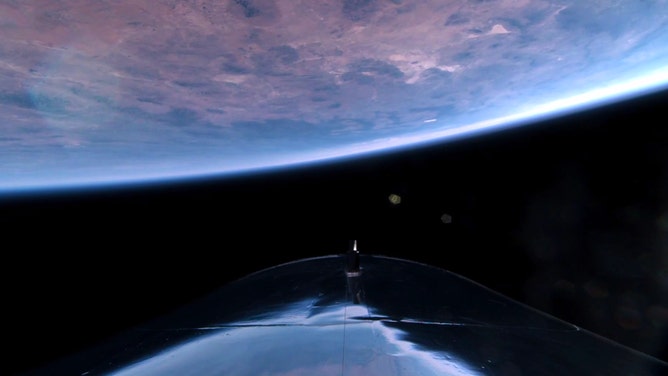Scientists launch on Virgin Galactic suborbital flight to conduct space research
Virgin Galactic's VSS Unity carried researchers Alan Stern and Kellie Gerardi to the edge of space to conduct research in low gravity, as well as a third private customer from Europe.
Virgin Galactic research flight touches down in New Mexico
Virgin Galactic's space plane VSS Unity touches down at Spaceport America in New Mexico after a trip to suborbital space with two space scientists and a private space tourist.
TRUTH OR CONSEQUENCES, N.M. – Virgin Galactic's spaceship launched two scientists and a space tourist into suborbital space Thursday to conduct research in low gravity.
There were three passengers on Virgin Galactic's VSS Unity: private European customer Ketty Maisonrouge, Southwest Research Institute planetary scientist Alan Stern and Kellie Gerardi, with the International Institute for Astronomical Sciences. The space plane carried the three private citizens to the edge of space to conduct research in low gravity.
The Galactic 5 mission took off from Spaceport America in New Mexico at 9 a.m. MDT.
After separating from the mothership, Virgin Galactic's SpaceShipTwo VSS Unity reaches 55 miles above Earth at peak altitude and provides minutes of weightlessness for up to four passengers.
ON THIS DAY: FIRST RESIDENTS OF THE ISS ARRIVED MORE THAN 20 YEARS AGO
Photos of Thursday's mission shared by Virgin Galactic showed the passengers inside the space plane cabin busy working on their experiments and also enjoying the stellar view of Earth.
VSS Unity touched down in New Mexico just after 10 a.m. MDT.

The view of Earth from VAA Unity during the Galactic 5 mission on Nov, 2, 2023. (Image: Virgin Galactic)
Stern, known for his role as principal investigator of NASA's New Horizons mission to Pluto, flew with two experiments.
"I'm ready to rock & roll!" Stern wrote on X hours before liftoff. "Meet you back on the planet after."
NASA'S LUCY SPACECRAFT MAKES FIRST ASTEROID FLYBY WHILE ZOOMING PAST DINKINESH
The first payload flying with Stern is a Xybion camera mockup, which is used for astronomical experiments and imaging objects in space. Stern wore a biomedical harness to measure his responses to high-gravity and microgravity environments. The device flew on 68 space shuttle flights.

Virgin Galactic Payload scientists Alan Sten (left) and Kellie Gerardi. (Image: Virgin Galactic)
Stern used this opportunity to train for a future NASA-funded suborbital flight as part of NASA's Flight Opportunities Program.
Gerardi flew three experiments on VSS Unity, including two healthcare technologies collecting biometric data. She examined how confined fluid behaves in low gravity and also wore a biomonitoring device, known as the Astroskin, developed with the Canadian Space Agency. She also wore a continuous glucose sensor to gather data on how blood glucose changes over the course of the low-gravity flight.
Maisonrouge, the third crew member who made the trip with the researchers, is of Franco-Italian nationality. Her name was released after the flight.
